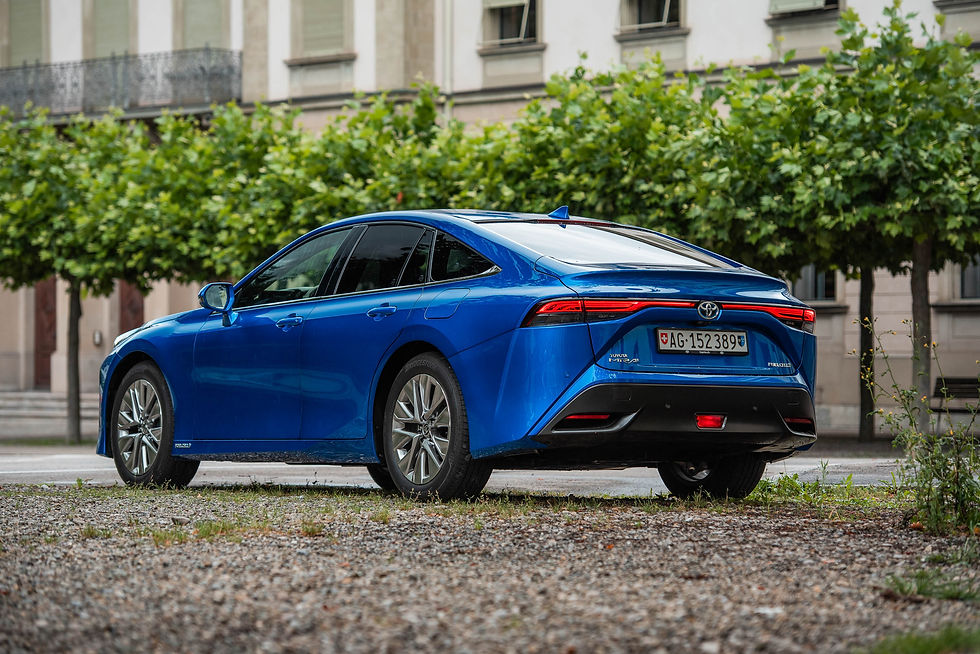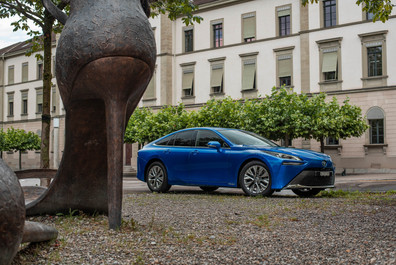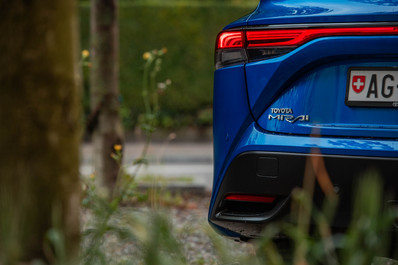The Toyota Mirai is a Hydrogen powered car you should know
- Robin P.M.

- 10. Sept. 2024
- 5 Min. Lesezeit
Many politicians claim that electric vehicles are the future of the individual’s mobility. I claim that Fuel Cell Electric Vehicles (FCEV) are a better option to reduce CO2 emissions. Here’s why:

If you know nothing about Hydrogen powered cars – Here’s a short overview:
Hydrogen cars are basically another form of electric cars. While electric vehicles are powered by batteries and electricity only, hydrogen-powered vehicles are equipped with a fuel cell and hydrogen tank.
Compared to batteries as an energy storage medium, hydrogen offers additional advantages in addition to the short refueling time, as it is lighter compared to petrol or diesel and ensures longer ranges. The only difference is the physical state. This is because hydrogen is not a liquid, but a gas. When refueling, it is compressed and pressed into the tank. If hydrogen is produced using renewable energies such as hydropower, wind, sun, biomass and geothermal energy, it is also completely CO2-free, as the only emission produced when hydrogen is converted into electricity is water. Hydrogen is also easy to store and transport and is available everywhere, making it a particularly exciting source of energy.
I remember a couple German car brands experimenting with hydrogen cars during the 2000s. But the technology has not been able to assert itself against the up-and-coming electric drive. However, the price of fuel cells has already halved since 2007. With increasing development, the use of hydrogen fuel cells will continue to increase and reduce their costs at the same time.

What is it all about?
The 2024 Toyota Mirai builds on a new platform. I expected some underpinnings to be provided by Lexus, although this isn’t a confirmed information. However, the new Toyota Mirai should start a new era as a top-of-the-line product with a reasonable price tag, futuristic looks and modern technology. The Mirai serves as an innovation vehicle to introduce and position hydrogen technology in the car market. Do you remember that American sedan which led its manufacturer to be one of the biggest car brands worldwide? The Toyota Mirai could start a similar career. The only difference is that Toyota is already the largest vehicle manufacturer on earth and is now boldly going its own way with experimenting and engineering. As it is with the modest hydrogen station density, it was the same situation ten years ago with charging stations for electric vehicles.

First impressions:
The Mirai’s second generation received a very appealing design compared to its predecessor which was based on a Toyota Prius and even looked like a disproportioned one, too.
There’re three different variations to choose from: “Business” as the base model with a starting price of CHF 66’900.- with fabric seats, “Premium” for CHF 69’500.- with faux leather and “Platinum” for a price of CHF 75’900.- with a real leather upholstery and larger alloy wheels. The only available option is the paintjob called “Force Blue” (CHF 1’400.-). The panorama glass roof would set you back an additional CHF 1’300.-.
There we are, in front of a luxurious limousine that costs a couple thousands less than CHF 80’000. In comparison, a Genesis G80 has slightly lower prices as the Mirai “Business”. On the other hand, the Genesis has high dealer markups and therefor more expensive than the Toyota.
In my point of view, the Mirai should have mounted some large VIP-looking alloy wheels for a more presidential appearance. There’s definitely some potential left.
Let’s have a seat.
The menu on the central screen can sometimes be a bit confusing and isn’t always that intuitive or simple in its handling. The regular Toyota navigation system looks fairly outdated and could react quicker compared to different systems I already used in various other cars or even new Toyota models like the bZ4X.
On the other hand, Toyota has placed the climate control buttons between the 12.3-inch screen and the center console. Seat heating and cooling, AC temperature and fan intensity can be controlled right there. Easy to handle. Exactly how it should be.
The boot has only 321 liters of space, which isn’t a huge number for such a large car, especially when direct rivals such as the Genesis G80 have as much as 424 liters. Additionally, the back seats can’t even fold down.
The back seats snug you in comfortably. As the leg and head room is more than enough, the Mirai could position itself as a great long-distance commuter for four passengers.
Let’s hit the road!
However, what really stands out is how quiet and refined the Mirai is; there is hardly any wind or road noise to speak of, and the mechanical bits are almost silent.
The Mirai also rides superbly, dealing with bumps and road scars far better than most other electric cars can manage. But don’t think this softly approach means it trips up at the first sign of a corner, because nothing could be farther from the truth. It’s actually quite nimble and keeps its body under tight control.
As the new Mirai has grown a lot, it measures 4.97m of length and 1.88m if width which makes it slightly difficult to maneuver it through tight parking garages and parking spots. Due to the long and flat C-pillar, the surround view is a bit limited.
The tanks hold 5.6 kilograms of hydrogen at 700 bar pressure, slightly more than its predecessor. The fuel is converted into electricity and water in the fuel cell, and some of the energy generated is temporarily stored in a buffer battery. The advantage here is that the Toyota only produces as much electricity as is needed at any given time. A clever, anticipatory and economical driving style pays off immediately. In city traffic I achieved a consumption of 0.9kg/100km and in the Swiss Alps an average consumption of 1.05-1.1kg/100km driving distance.
The disadvantage of hydrogen energy is that hydrogen is produced from electricity and electricity is produced again with hydrogen in the car. This leads to energy losses in each conversion process. It is clear that a purely electric car has an advantage here. However, a hydrogen-powered vehicle can make up for this due to the much smaller battery.

What should I buy?
The filling station network for hydrogen is being expanded slowly but steadily. We remember the market launch of the first electric vehicles. At that time, the charging infrastructure was also only sparsely developed. It’s just a matter of time on how quick hydrogen powered cars are getting launched on the car market. The advantage of hydrogen, however, is that the existing gas station infrastructure can be converted and continue to exist. There’re a few websites already where you can discover all the H2 filling stations in Switzerland:
The new Toyota Mirai is a luxurious sedan, priced with a reasonable and fair price tag in terms of its production and engineering costs. I position its usability above any electric vehicle due to regular gas station brakes compared to long charging procedures.
As well as the Mirai drives, the jury’s still out on whether or not it is worth buying or not. If you’re determined to make a statement that you’re ‘a bit different’, and you live a short distance from those somewhat scarce filling stations, then you’ll be getting a great-driving car that isn’t extremely roomy.
To end this review, I wanted to thank Toyota Switzerland for lending me their Mirai to properly test drive for two weeks. I bet that hydrogen powered cars will play a bigger part in the automotive future.
Review & photos by: RPM | Robin P. M.


























Kommentare